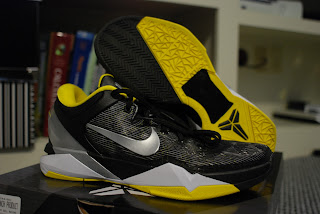Nike Kobe VII (7)
I haven't done one of these in awhile, probably because I haven't stepped on a basketball court in ages, due to hockey season. But in light of the recent release of the Nike Kobe VII System, I just had to step on the hardwood again to try them out. For those not familiar with the Kobe System and it's satirical and comedic advertisements, it's the concept of customizable basketball footwear based on user preference for both comfort and performance. The same design concept applied by Jordan Brand in their successful Air Jordan 2011, which upped the ante even more so for their 2012 model (I'll probably review that as well once I find a colorway I like).
Nike Kobe VII (7) System packaging
First impressions are everything. The marketing and 'push' for the Kobe system skyrocketed this year due to it's design concept and advertisements. From 2011, it really isn't anything new or ground breaking, but it's a first for the Kobe line. Based on hype alone, Nike may have oversold themselves on this one.
The Nike Kobe VII System comes with one (1) pair of shoes and two (2) insole cushioning inserts - 'Attack Fast' and 'Attack Strong'. The upper of the Kobe VII features a full Flywire construction, outer lacing system, outrigger support, molded collar, phylon mid-sole and overall low cut design. All the things that are all too familiar in the Kobe line, with the addition of a 3D heel clip to ensure lock-down support, a glass composite mid-foot shank and herringbone traction.
Play Strong insert (Left); Play Fast insert (Right)
Comparing this generation to it's low-cut predecessors, the Kobe VII ended up being a little heavier this year. You can only cut so much weight until you compromise performance, so I personally didn't mind the weight of the shoe, as long as it wasn't a brick coughFoampositecough. Because of the extra support needed for interchangeable insoles, I guess Nike felt it was necessary to beef up the mid-sole area and strengthen the heel cup.
Fit/Comfort
The upper construction of the shoe consists primarily of Flywire, which was lined with some sort of polyurethane casing which made them stiff upon my first wear. It wasn't as stiff as the Kobe Vs, but also wasn't as flexible and forgiving as the Kobe VIs or IVs. As far as ventilation goes, one drawback to having Flywire is that it doesn't allow of any ventilation like mesh or leather does (leather can be perforated), which cause major problems later.
Flywire upper w/ synthetic support overlay
Standing on both feet felt great as far as fit goes. The 3D heel clip and molded collar would have done an excellent job if it weren't for the edge of the insole pushing my feet forward and away from the heel when I was running. This resulted in poor lock down fit in the heel area. Kobes' IV - VI gave me no problems at all as far as lock down goes, but it seems the interchangeable insoles were causing the problem.
3D heel clip for support and stability
Although the shoe was snug fitting, the lack of heel lock-down caused my feet to move inside the shoe due to the nature of the interchangeable insole. The lacing kept my forefoot still but the heel moving up and down when running caused my forefoot to rub closely on the edges of the insert. The insert also bends and rubs on the foot because the walls of the insert are so high. Combine that with heavy perspiration, it results in terrible blisters. I've never experienced such a thing with the Air Jordan 2011, or with any shoe for that matter.
The insert: where it's folded is where it started to rub on my feet
5/10
Ankle Support
Let me just get this out of the way: the ankle wrap does absolutely nothing. It really didn't add any extra protection at the ankle, other than the fact that it restricted a bit of movement, although not that much. So let's not put that into consideration.
Molded collar for ankle support and heel lock down.
In light of the useless ankle wrap, the molded collar and 3D heel clip, again, did a great job in holding together my ankle. However, because of the extra movement in the shoe from the insole, I did slip once or twice out of position and nearly rolled my ankle. It could be just me, but from what I have read, alot of people are experiencing the same problems.
7.5/10
Nike made a wise decision in bringing back the triangular herringbone traction pattern on the out-sole of the forefoot. The Kobe IV was nearly perfect in terms of traction for this reason. Toe off felt comfortable and stuck to the ground like it supposed to. The crash pad on the heel felt better on the IVs and VIs though.
Traction pattern with the 'shatter' pattern and herringbone on the forefoot.
9/10
Cushioning/Stability
The 'Attack Fast' insert comes with an inner neoprene 'Power Stretch' sleeve that hooks onto the insert, which fits like a low cut sock when put on. The insole includes both heel and forefoot Zoom Air for quick transition response. The glass-composite carbon shank relieves any duties for mid foot cushioning, so full-length Zoom isn't really required.
Attack Fast insert
Forefoot Zoom Air
Heel Zoom Air
In terms of fitment, I liked these a little more than the 'Attack Strong' insert, just because I didn't have to deal with the ankle wrap. But that's irrelevant in this segment. The Zoom Air was responsive and placed exactly where I needed it. However, I had no idea why Nike (by Nike, I mean Eric Avar) placed the Zoom Air deep under the phylon at the heel when the foam is that thick. Initially, it felt great but eventually, you have to really stomp and break down that phylon to compress the Zoom that's hiding under it. My guess, upon thinking about it more after my run, is that the Zoom Air under the phylon was designed to bounce off the outsole of the shoe rather than push the heel off directly. For me, it didn't work too well.
Attack Strong insert w/ Cushlon foam
The 'Attack Strong' insert comes with that same neoprene 'Power Stretch' material only in the form of an ankle wrap. The entire mid-sole is comprised of Cushlon- a pillowy, bouncy foam that provides impact protection and landing. The Although this insert gave me the most problems in terms of fitment, it was my favorite insert in terms of actual cushioning. I loved running in the Cushlon more so than the Zoom because of the nice ride that was easy on my bum knee. I'm also more of a spot up shooter than a quick slasher, so this type of cushioning was more fitting for a player like myself.
8/10
Overall
Because of my positive personal experience with the Air Jordan 2011, I was dying to try the Nike Kobe VII System. With the interchangeable mid-sole concept from the Air Jordan 2011 fused with the low cut stylings and technology that comes hand in hand with the Nike Kobe line, I got the best of both worlds, right?
Well, let's just say this: I loved the traction and cushioning, I loved the aesthetics and presentation, and I really loved the TV ads. But honestly, all that is overshadowed by poor fitment and execution of a proper interchangeable mid-sole system. The lack of heel lock down and chaffing caused major problems and discomfort and ultimately, led to injury. I actually spent a week inactive due to blisters on BOTH feet.
Perhaps, in the future I will either use thicker socks or go up half a size and run another review. But for now, based on my current experience with the Kobe System, it is an utter disappointment for a shoe that costs nearly $200 US. Bring on the Air Jordan 2012.
Overall Rating: 7/10
One.


















nice review. the shoes seem whatever compared to the price. the best kobe basketball shoe is still the v's in my opinion.
ReplyDeleteglad to see you got your hands on a pair of the all-stars though!